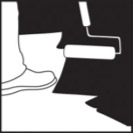Seal the Deal is intended to be an informative and educational publication for ChemMasters’ network of independent manufacturer’s representatives, distributors and contractors. We don’t want to make you chemical engineers, but we do want to help you feel better informed and more comfortable discussing construction chemicals. If there are specific products or topics you would like to see addressed in a future issue, please contact
John Fauth.

Many traditional curing methods, such as water application by sprinkling, ponding, or absorbent materials, shouldn’t be used on decorative concrete flatwork because they will discolor the concrete. Covering the finished flatwork with plastic sheeting
or curing paper is also problematic because these products don’t lie flat enough to avoid mottling. Use of a liquid membrane- forming compound having special properties for curing and sealing concrete and meeting the requirements of ASTM
C1315, "Standard Specification for Liquid Membrane-Forming Compounds Having Special Properties for Curing and Sealing Concrete," is the only method that will produce acceptable results for textured stamped concrete. These compounds are commonly called "cure-and-seal products" or
simply "cure-and-seals."
Timing for applying the cure-and-seal product is different for textured stamped concrete. Section 3.2.2.1 of ACI 308.1- 11,"Specification for Curing Concrete," requires application
of curing compounds immediately after final finishing. Unfortunately, some people interpret this to mean that cure- and-seals must be applied immediately after the stamping mats are picked up. That, however, is neither possible nor desirable because of the steps needed in the
stamping process.
Stamping must be done while the concrete is still plastic enough to take an impression by the stamping mats. Because the concrete is still plastic, workers can’t walk on the concrete surface and are either outside of the forms or on the stamping mats. Before stamping mats can be
laid on the concrete surface, a powder or liquid release agent is applied to the flatwork to prevent the mats from sticking to the concrete and marring the surface when they’re picked up. The release agents also add a contrast color that enhances the final appearance.
To prevent footprint indentations, workers stand on adjacent mats or outside the forms when they pick up the mats.
After the concrete has hardened, the surface is rinsed with water to remove excess release agent and dust produced by any joint sawing. Rinsing can’t be done on the day of placement—it must be delayed until the concrete is hard enough for a worker to stand on the surface without
marring it. If rinsing is done before the concrete has hardened sufficiently, the water will damage the surface. All of the steps described here constitute the final finishing process. Cure-and-seal products should be applied
only after the release agent has been rinsed off and the rinse water has dried.
The best practices for curing textured stamped concrete also include the following steps:
- Avoid conditions of low humidity, strong winds, and hot weather that increase the rate of bleed water evaporation. Placing concrete in the early morning or late evening is the most practical way to do this if postponing placement is not an option.
- Initially cure the concrete immediately after placement. Methods for doing this are described in Section 3.1.1 of ACI 308.1-11. The most practical method is spraying an evaporation retardant on the surface after strike off and between floating steps. Select an
evaporation retardant that is compatible with colored concrete applications.
- Use decorative cure-and-seal products that meet the curing requirements while improving the finished decorative look. Products that meet ASTM C1315, which are Class A
non- yellowing and breathable, will be most beneficial. Some breathability is important because water collecting under the sealer can cause numerous problems, including a whitish discoloration called blushing. Exceeding the manufacturer’s recommended application rate can also
cause problems. Applying the sealer at the manufacturer’s recommended application rate creates a curing membrane that still allows moisture vapor to pass through at a controlled rate. The membrane also provides a base for a thin second coat of the same product that can be
applied to create the desired decorative look.
Using these best practices satisfies the need for curing and produces a superior finished appearance for textured stamped concrete. Preplanning, employing the best practices, and selecting proven products can satisfy all the requirements for a long lasting, beautiful surface.
Decorative concrete contractors will work with owners and architects to develop specifications and establish methods for addressing technical requirements that honor the desired final appearance. If you have questions, contact your decorative concrete contractor or the ASCC
Decorative Concrete Hotline at (888) 483-5288.

As published in Concrete International, a publication of the American Concrete Institute.
Reprinted with permission of the Decorative Concrete Council of the American Society of Concrete Contractors.
Seal the Deal is intended to be an informative and educational publication for ChemMasters’ network of independent manufacturer’s representatives, distributors and contractors. We don’t want to make you chemical engineers, but we do want to help you feel better informed and more comfortable discussing construction chemicals. If there are specific products or topics you would like to see addressed in a future issue, please contact
John Fauth.

 Seal the Deal
Seal the Deal


